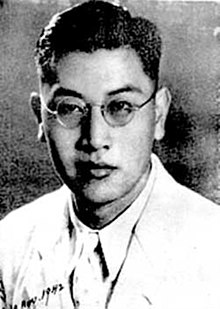42:
99:
198:
Given the birth name Dai
Chaocai (Chinese: 戴朝寀; pinyin: Dài Cháocǎi), Dai Wangshu was born in Hangzhou, Zhejiang province. In 1923, he was admitted as a student into Shanghai University. Two years later, he would transfer to Aurora University where he studied French.
209:
at the
University of Lyon's Institut Franco-chinois and published several poems in French. He collaborated in translating modern Chinese literature with French writer and academic
162:
He was closely associated with the
Shanghai Modernist school, also known as New Sensibility or New Sensation School, a name inspired by the Japanese modernist writer
256:
lyric texts can also be discerned in his early poems. Some scholars have assumed that this "symbolist influence" came from more well-known French poets such as
271:
In the late 1940s, when he had returned from Europe and shifted from Neo-symbolism to a more generally modernist style (that drew also on
182:, whose Third Category thesis (that a writer could be on the left but remain independent) Dai defended against the hard line taken by the
383:
179:
337:
Dai
Wangshu, "Mis recuerdos". Introducción y traducción del chino de Javier Martín Ríos (Barcelona: La poesía, señor hidalgo, 2006).
378:
314:
398:
388:
264:. However, while Dai Wangshu and other poets in China knew Verlaine's work through the versions of the English symbolist
85:
63:
56:
229:
373:
143:, was a Chinese poet, essayist and translator active from the late 1920s to the end of the 1940s. A native of
393:
152:
347:
221:
50:
290:
232:. During this period Dai developed acute asthma. After the war, he returned to Shanghai and then
202:
In 1929, his first collection of poems entitled "My Memory" (Chinese: 我的记忆) would be published.
236:, and died there having accidentally overdosed on the ephedrine he took to control his asthma.
67:
368:
363:
8:
244:
His early poetry has numerous intertextual links with the French Neo-symbolist poetry of
183:
228:
as a newspaper editor. He was arrested and put into jail for several months during the
210:
286:
277:
268:, there is no evidence of an early close inter-textual relationship with Baudelaire.
214:
163:
110:
24:
327:
249:
128:
350:
at
Portrait Gallery of Chinese Writers (Hong Kong Baptist University Library).
357:
294:
265:
29:
253:
171:
20:
310:
261:
175:
167:
245:
225:
257:
156:
148:
144:
233:
272:
206:
187:
118:
98:
282:
332:
Dai
Wangshu: The Life and Poetry of a Chinese Modernist
239:
355:
334:(Hong Kong: Chinese University Press, 1989).
213:, and met contemporary French poets such as
289:, was the first to translate the poetry of
139:; March 5, 1905 – February 28, 1950), also
86:Learn how and when to remove this message
348:Dai Wangshu. A Portrait by Kong Kai Ming
193:
97:
49:This article includes a list of general
133:
16:Chinese poet and translator (1905–1950)
356:
205:Between 1932 and 1935 Dai studied in
275:texts), Dai translated Baudelaire's
252:. Yet many references to pre-modern
35:
281:into Chinese. Dai, who had visited
13:
300:
240:Poetic influences and translations
166:. Other members of the group were
55:it lacks sufficient corresponding
14:
410:
341:
384:20th-century Chinese translators
230:Japanese occupation of Hong Kong
40:
379:20th-century Chinese essayists
123:
1:
321:
159:in 1926, majoring in French.
399:Drug-related deaths in China
7:
309:featuring Dai Wangshu. Ed.
10:
415:
389:20th-century Chinese poets
307:Chinese Writers on Writing
18:
114:
315:Trinity University Press
151:, he graduated from the
70:more precise citations.
103:
374:Writers from Hangzhou
291:Federico García Lorca
194:Early life and career
101:
248:and, in particular,
394:Poets from Zhejiang
184:May Fourth Movement
104:
287:Spanish Civil War
278:Les Fleurs du mal
222:Sino-Japanese War
215:Jules Supervielle
153:Aurora University
96:
95:
88:
406:
224:, Dai worked in
164:Riichi Yokomitsu
137:
125:
116:
91:
84:
80:
77:
71:
66:this article by
57:inline citations
44:
43:
36:
414:
413:
409:
408:
407:
405:
404:
403:
354:
353:
344:
324:
303:
301:Further reading
242:
196:
92:
81:
75:
72:
62:Please help to
61:
45:
41:
34:
17:
12:
11:
5:
412:
402:
401:
396:
391:
386:
381:
376:
371:
366:
352:
351:
343:
342:External links
340:
339:
338:
335:
328:Gregory B. Lee
323:
320:
319:
318:
302:
299:
297:into Chinese.
250:Francis Jammes
241:
238:
195:
192:
94:
93:
48:
46:
39:
15:
9:
6:
4:
3:
2:
411:
400:
397:
395:
392:
390:
387:
385:
382:
380:
377:
375:
372:
370:
367:
365:
362:
361:
359:
349:
346:
345:
336:
333:
329:
326:
325:
316:
312:
308:
305:
304:
298:
296:
295:Pedro Salinas
292:
288:
284:
280:
279:
274:
269:
267:
266:Ernest Dowson
263:
259:
255:
251:
247:
237:
235:
231:
227:
223:
218:
216:
212:
211:René Étiemble
208:
203:
200:
191:
189:
185:
181:
177:
173:
169:
165:
160:
158:
154:
150:
146:
142:
138:
136:
130:
126:
120:
112:
108:
100:
90:
87:
79:
69:
65:
59:
58:
52:
47:
38:
37:
32:
31:
26:
22:
331:
306:
276:
270:
254:Tang Chinese
243:
219:
204:
201:
197:
161:
141:Tai Van-chou
140:
135:Tai Wang-shu
134:
132:
122:
106:
105:
82:
73:
54:
28:
21:Chinese name
369:1950 deaths
364:1905 births
285:before the
220:During the
124:Dài Wàngshū
107:Dai Wangshu
102:Dai Wangshu
68:introducing
25:family name
358:Categories
322:References
311:Arthur Sze
262:Baudelaire
176:Shi Zhecun
168:Mu Shiying
129:Wade–Giles
51:references
246:Paul Fort
226:Hong Kong
172:Liu Na'ou
317:, 2010).
258:Verlaine
186:veteran
157:Shanghai
149:Zhejiang
145:Hangzhou
76:May 2023
19:In this
234:Beijing
180:Du Heng
111:Chinese
64:improve
273:Daoist
207:France
188:Lu Xun
178:, and
131::
121::
119:pinyin
113::
53:, but
23:, the
283:Spain
293:and
260:and
313:. (
115:戴望舒
30:Dai
27:is
360::
330:,
217:.
190:.
174:,
170:,
155:,
147:,
127:;
117:;
109:(
89:)
83:(
78:)
74:(
60:.
33:.
Text is available under the Creative Commons Attribution-ShareAlike License. Additional terms may apply.
